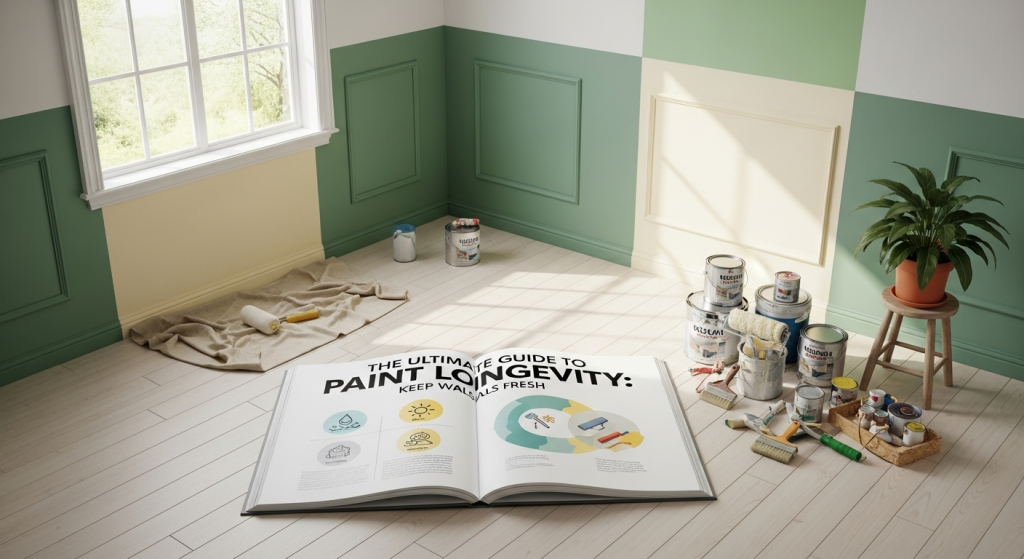
The real worth of a professional paint job lies not in the immediate vibrancy of color, but rather in the longevity of that color. Investing in premium paint is only beneficial if accompanied by a solid maintenance strategy. This comprehensive guide goes beyond the fundamental aspects of application and thoroughly explores the post-painting lifecycle, providing practical recommendations to ensure your walls maintain a freshly painted appearance for years, even in areas with high traffic and moisture.
Phase 1: Post-Application Care (The First 30 Days)
The paint may feel dry, but it takes several weeks to fully cure. The first 30 days are crucial to ensuring durability and longevity.
A. The Curing Period: Key Tips
- Understand Curing Time: Most interior paints dry to the touch within hours but take 3–4 weeks to fully cure. During this period, the paint film hardens and achieves its full durability.
- Avoid Harsh Cleaning: Do not wash or scrub the walls while curing. Even gentle wiping can damage the soft film and cause permanent streaks.
- Handle Surfaces Gently: Avoid leaning furniture or hanging art on newly painted walls. Scuffs during this period are harder to repair.
- Maintain Good Ventilation: Keep windows open or fans running to aid solvent evaporation and strengthen the paint film.
B. Proper Paint Storage for Touch-Ups
- Transfer Paint: Pour leftover paint into airtight glass jars or sturdy plastic containers. Avoid rusty or half-empty cans.
- Label Clearly: Include details such as Room Name, Color Code, Brand, and Date for future reference.
- Store in Moderate Conditions: Keep paint in a cool, stable environment (like a hall closet). Avoid freezing or overheating, which can ruin paint composition.
Phase 2: Routine Cleaning and Stain Removal
Routine maintenance keeps walls fresh and prevents buildup of dust, grime, and stains. Cleaning methods depend on the paint’s sheen.
A. Sheen-Specific Cleaning Methods
Flat / Matte Paint
Best Use: Low-traffic areas, ceilings, and formal rooms.
Cleaning Method:
Use a barely damp, clean microfiber cloth.
Gently blot or wipe the surface without pressure.
Avoid:
Vigorous scrubbing or abrasive cleaners — these can cause burnishing (permanent shiny spots).
Eggshell / Satin Paint
Best Use: Bedrooms, dining rooms, and hallways (good balance of look and durability).
Cleaning Method:
Use a soft sponge with a mild solution of warm water and a few drops of dish soap.
Gently wipe and then dry with a clean cloth.
Avoid:
Bleach, ammonia, or highly acidic cleaners that may dull the finish.
Semi-Gloss / Gloss Paint
Best Use: Kitchens, bathrooms, trim, and doors (areas needing higher durability).
Cleaning Method:
Can handle gentle scrubbing using a soft-bristled brush or mild degreasing cleaner.
Rinse with clean water and dry immediately.
Avoid:
Abrasive scouring pads or strong solvent-based spot removers — these can scratch or strip the gloss finish.
Phase 3: Repairing and Blending Imperfections
Small damage is inevitable. The goal of a repair is to make the imperfection disappear seamlessly.
A. Preparation: Fixing the Flaw
Before applying paint, the surface must be structurally sound and smooth.
Dents and Chips: Use a tiny amount of lightweight spackle to fill the dent or chip. Allow it to dry completely.
Sand Smooth: Using fine-grit sandpaper (180-220 grit), gently sand the spackled area until it is perfectly level and smooth with the surrounding wall. Wipe away all sanding dust.
B. The Seamless Touch-Up Technique
The mistake most homeowners make is using a large brush and a thick layer of paint.
Choose the Right Tool: Use a small artist’s brush (for small chips) or a foam craft brush (for larger patches). This allows for maximum control.
Thin Layers Only: Dip the brush and wipe off most of the excess paint. Apply two or three thin, feathered coats, rather than one thick coat. Thick coats look heavy and will always be visible.
Feather the Edges: When applying the final coat, use a stippling motion (tapping the brush straight onto the wall) and blend the edges lightly into the surrounding wall texture. This “feathering” makes the touch-up disappear into the existing finish.
Phase 4: Preventing Environmental Damage
Two environmental factors are responsible for the vast majority of premature paint failure: sunlight and moisture.
A. Combating UV Fading
Direct sunlight breaks down the chemical bonds in paint pigments, leading to fading, chalking, and a loss of color vibrancy, especially with deep reds and blues.
Choose the Right Product: When painting south- or west-facing rooms that get intense light, invest in high-quality, 100% acrylic latex paint. These formulas contain UV-resistant resins and pigments that slow down the degradation process.
Control the Light: Use UV-filtering window film, blinds, shades, or curtains to block intense, direct afternoon sun, protecting not only the paint but also your floors and furniture.
B. Managing Moisture and Humidity
Moisture is paint’s biggest enemy in bathrooms, kitchens, and basements. It causes the paint film to lose adhesion, resulting in peeling, bubbling, and blistering.
Ventilation is Mandatory: Always run the exhaust fan during and for at least 30 minutes after showers or while cooking. This removes the moist air before it settles on the walls and ceiling.
Use the Right Sheen: Always use a semi-gloss or gloss paint in high-moisture areas. Their tight, smooth film is far less porous than a flat or eggshell finish, making them much more water-resistant and easier to clean.
Address Leaks Instantly: If you notice a ceiling or wall patch bubbling, it is almost certainly a leak. Immediately find and fix the water source before scraping the damaged paint, allowing the surface to dry completely, and touching up the area.
By following this comprehensive four-phase guide, you move beyond simple upkeep. You adopt a proactive maintenance strategy that preserves the finish, minimizes visible wear, and ensures your beautiful paint job truly stands the test of time.
Lorem ipsum dolor sit amet, consectetur adipiscing elit. Ut elit tellus, luctus nec ullamcorper mattis, pulvinar dapibus leo.
Conclusion
In conclusion, the durability of paint is not a matter of chance; rather, it stems from consistent and thoughtful upkeep. By perceiving your paint as more than mere decoration, but as a protective layer, you transition from merely responding to damage to actively preventing it.
From honoring the essential curing period to selecting the appropriate gentle cleaner for a matte finish, and from carefully storing your touch-up paint to utilizing a simple exhaust fan to mitigate moisture, every minor effort you make plays a crucial role in extending the lifespan of the finish.
Adopt these practices, and you will not only maintain the beauty and vibrancy of your initial investment but also guarantee that your walls continue to serve as a stunning and resilient backdrop for your home for many years ahead. Your exquisite paint job merits this additional level of attention.
